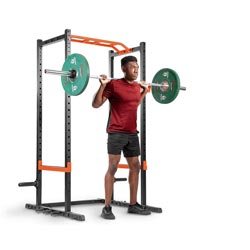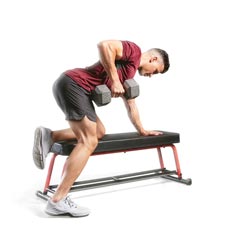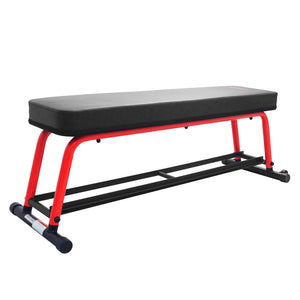What Is Your Goal? Answer: More Muscle
The two most common fitness goals are to lose fat and gain muscle. What you might not realize is that the more muscle you have, the less fat you will carry (assuming your diet is in a good place) because having more muscle mass increases the number of calories your body burns to maintain itself.
So, more muscle = more calories burned just BY LIVING = less body fat over time
In a way, whether your goal is to lose fat or to gain muscle, what you want to do is gain muscle or at least maintain it.
Even if your goal is not to look like a bodybuilder, training specifically to increase muscle mass (known as Hypertrophy Training) can move you towards your goal of looking better, feeling better, fitting into clothing better, and all the other good stuff.
Does this mean you should stop running on the treadmill, doing yoga, or participating in your favorite fitness class? Not even a little bit! It means that some of the time you spend on fitness—for example, the time spent lifting weights—can be used for the specific purpose of increasing muscle size. That’s what hypertrophy training is.
So just incorporating some of it into your fitness regimen can be a very good thing.
And if you’re female, don’t worry about getting bulky or looking like a man. For one thing, though there are exceptions, biological women generally do not produce adequate testosterone to obtain man-like muscle size.
And secondly, building muscle is a lot of work, and seeing results from hypertrophy training takes a long time.
It’s like I always say (and it’s true for men, too): don’t worry about the muscle you don’t have! It’s hard to build muscle and it takes TIME. No matter how much hypertrophy training you do, you won’t wake up one day looking like Arnold Schwarzenegger. Trust me!
Ok, Now What Exactly is Hypertrophy Training?
As mentioned, hypertrophy training refers to exercise programming that is designed specifically to increase muscle size. The end goal is not maximum strength, maximum endurance, maximum anything other than maximum muscle size. Of course, some of those outcomes may occur, but the end goal is more muscle. Plain and simple.
A Note on Nutrition
An important part of maximizing the results of hypertrophy training is proper nutrition. Although all the macro- and micronutrients are important, the most crucial element for maximizing muscle is protein.
For a deep dive into maximizing both protein intake and protein sources (because you can’t eat just one!), check out this Nutrition Plan to Gain Muscle, and for insights into setting your calorie and protein goals, our Muscle Building Nutrition 101 article will give you the tools you need.
And remember, if you cheat on your diet more often than you follow it, you’re not on a diet: your diet is on you!
So How Does Hypertrophy Training Work?
The general wisdom is that hypertrophy occurs best in the 8 to 12 rep range. The higher rep range means the muscle is subjected to stress for a longer period. Hence, over time, the muscle is “forced” to increase in mass in order to adapt to this increased stress.
Notice how I said, “over time.” You must do hypertrophy training regularly for a while to see results; any workout that says, “Add an Inch to Your Biceps in One Hour!” is not being truthful.
What Kind of Programming Typifies a Hypertrophy-Oriented Program?
The most classic way to organize hypertrophy training is known as the Body Part Split or, somewhat sardonically, the Bro Split. This is when you exercise one muscle group, or two tops, per workout on specific “Days.” A common 5-day split would be Chest Day, Back Day, Shoulder Day, Leg Day, and Arm Day.
If you’ve ever tried this type of split, I salute you. It is very challenging, if for no other reason than because being in the gym five days a week and pushing yourself, rather than halfheartedly, requires great dedication, including with regards to diet, sleep, and stress management.
Other common splits include Push/Pull/Legs (six days per week), Lower/Upper (four days per week), or Full-Body Workouts (three to five days per week). They all come with their own caveats, but the main thing that’s important is to choose the program you can stick to.
At the end of this article, I’ve included a three-day-per-week program that might just be perfect for you. But if you’d like to try these other splits, you can easily reorganize it into the one that interests you.
What Are the Best Exercises for Hypertrophy Training?
There are those who say you must focus on the compound lifts—bench, squat, deadlift, overhead press, row, pullup, and dip—to maximize muscle growth. This is true; they should form the foundation of what you do. But in order to MAXIMIZE muscle growth, some “isolation” work is necessary.
The reason for this is twofold. A) Compound lifts don’t hit certain smaller muscles enough to generate adequate fatigue to drive muscle growth, leading to muscle imbalances, and B) it’s easy to overtrain if you do nothing but compound lifts. Isolation lifts are easier to recover from.
Muscles that commonly require isolation work to receive adequate stimulus include the triceps, biceps, rear delts, hamstrings, calves, forearms, neck, traps, and the core muscles (abs, obliques, glutes, and lower back).
How Do I Choose Which Muscles to Hit?
I know that list looks long! If you want to try to hit them all, go for it! (See how hard real bodybuilders work?!)
But your hypertrophy workouts don’t need to include every muscle. When you’re just starting out, focus on compound lifts and add in whatever isolation work you have time for.
Or choose what you enjoy.
Or choose what helps fend off injuries, like strengthening your lower back.
Or choose what looks cool; maybe you like the Huge Traps look, or you want a bigger booty or maybe a visible six pack someday.
Let these preferences decide where to focus your efforts, and your results will be better, less arbitrary, and easier to stick to.
The next step is figuring out which lifts work the area you’re trying to work the best. If you’re not sure, keep it simple: does it make you sore there a day or two later? Then it’s a good one. If it doesn’t, double-check your form and if it still doesn’t, consider switching exercises.
Did it used to make you sore, and it doesn’t now? Only switch if you’re no longer progressing.
What Are Some Tools for Enhancing Hypertrophy?
These are the most common, time-tested, tried-and-true strategies for increasing muscle growth. Some of them are backed with real science (like sets to failure and BFR training) and others are just backed with “bro science,” but if you ask the most jacked people in the gym what a “drop set” is, there’s a good chance they know and that they use drop sets themselves.
Why? Because they can work. Try a few and see which strategies work for you.
- Sets to Failure: doing so many reps that you can no longer perform another rep without breaking form. Ideal for isolation exercises.
- Drop Sets: going to failure or very close to it on a certain weight, putting the weight down and reducing it slightly, and then without resting, continue lifting until reaching failure again, and repeat as desired. Ideal for “selectorized” weight machines where you can change the weight almost immediately.
- Rest-Pause Sets: Much like a drop set but no reduction in weight. Doing a certain weight until failure, rest for 20-30 seconds, and then pick the weight back up and continue until failure again, repeating 2-3 times
- AMRAPs: As Many Reps As Possible are performed, usually on only one set (the last one), often with lighter weight
- BFR Training: Blood Flow Restriction training, in which elastic bands are placed around the upper extremities to trap blood in the muscle while lifting very light weights for up to 30 reps per set
- Slow Eccentrics: during the portion of the lift when the muscle is being stretched, the weight is moved more slowly to create more muscle damage
- Weighted Stretch: maintaining a certain muscle in a stretched position while holding weight, which is believed to increase the muscle’s capacity for total growth
Notice how many of these strategies involve pushing you closer to failure. That’s not a coincidence. While it is possible to maximize strength at submaximal effort levels, maximizing hypertrophy is directly tied to how close to failure you train. You don’t want to train to failure on every exercise (Deadlifts? Good mornings? Please don’t!), and you don’t want to do it on every set either, but you must train within a certain threshold in order to not waste time. Experiment and see what works for you.
Integrating Some Hypertrophy Training into Other Fitness Regimens
You don’t have to do a full-blown “hypertrophy program” to get the benefits of hypertrophy training. Just choose a few muscles—maybe chest, back, and hamstrings—and add some of this kind of training, and you’ll be in great shape.
Everyone should be building muscle: all ages, all genders, and all stages of life. Why? Because everyone should have a strong metabolism, be self-reliantly mobile, and be able to move objects as needed without help. Some muscle growth can occur with any style of resistance training but integrating some hypertrophy training into your routine is always a good idea.
Three-Day-Per-Week Lower/Upper Workout
Credit where credit is due: elements of this workout derive from Dante Trudel’s DC Training method, though it is NOT DC training per se.
Notes: Warmup sets do not count towards the total. Reps are higher on Day Three because those muscles will have more time to rest. Track your progress and try to improve in reps or weight each workout. If you have trouble recovering, reduce the “straight sets” (meaning the “normal” sets preceding the Rest-Pause, Drop Set, et cetera). Keep workouts to no more than 90 minutes.
Legend: Sets x Reps. “2x8-12” means “2 Sets of 8 to 12 Reps”
WEEK ONE
Day One: Lower
Hanging Leg Raises 2x10 plus one Rest-Pause Set
Barbell Back Squat 2x8-12, then reduce weight and do 1x15-20 (not to failure but close)
Seated Leg Curl 2x8-12 plus 1x8 with Slow Eccentrics
Weighted Glute Bridge 2x10-15 plus one Rest-Pause Set
Incline Dumbbell Hammer Curl 2x8-12 plus one Drop Set
Day Two: Upper
Incline Bench Press 2x8 plus one Rest-Pause Set
Upright Row 3x8 with Slow Eccentrics
Bent-Over Barbell Row 2x10 plus one Drop Set
Wide-Grip Pulldown 2x8-15 plus one Dro
Set
Overhead Triceps Extension (barbell or dumbbell) 3x12 plus one Weighted Stretch
Day Three: Lower
Weighted Crunches 3x10
Leg Press 3x8-12 plus one Rest-Pause Set
Ball Ham Curl 3x12 plus 1x8 with Slow Eccentrics
45-Degree Lower Back Extension 3x12 (not to failure)
Standing Cable Bicep Curl 3x8-12 plus one Drop Set
WEEK TWO
Day One: Upper
Flat Bench Press 2x8-12 plus a Rest-Pause Set
Lateral Raise 2x8-12 plus one set with Slow Eccentrics
Chest-Supported Machine Row (not barbell to avoid affecting deadlifts on following workout) 2x8-12 plus one Drop Set
Chindown (underhand pulldown) 2x8-12 plus one Drop Set
Machine Dips 2x12 plus one Drop Set and a Weighted Stretch on the last rep
Day Two: Lower
Weighted Planks 3x30-60 seconds
Snatch-Grip RDL 2x8 plus 1x6 with Slow Eccentrics
Lying Leg Press 2x8 plus one Rest-Pause Set
Seated Calf Raise 1x10-12 plus one set with Slow Eccentrics
Overhand Barbell Bicep Curl 2x12 plus one set with Slow Eccentrics
Day Three: Upper
Overhead Press 3x8-12 plus one Rest-Pause Set
Machine-Assisted Pullups 3x8 plus one Drop Set and a Weighted Stretch on the last rep
Plate-Loaded Bench Press 3x10 plus one Rest-Pause Set
Cable Tricep Pushdowns 3x10-12 plus one Drop Set
Unilateral Dumbbell Row 3x10 plus one Drop Set and a Weighted Stretch on the last rep


Mark Ludas CPT is a NASM-certified personal trainer with a decade of experience in the fitness industry. After an asthmatic childhood, Mark discovered his natural aptitude for fitness in his late twenties. At age 36, he accomplished a 300+ pound conventional deadlift and 280+ high-bar squat as a 6’5” 170-pound ectomorph on a fully vegan diet, all after just one year of proper self-programming. Mark is the founder of Resistance Quest Fitness, established in 2016. Additionally, he is a writer, actor, model, and musician. Find him on Instagram, Facebook, Youtube, and at www.resistancequest.com.






















